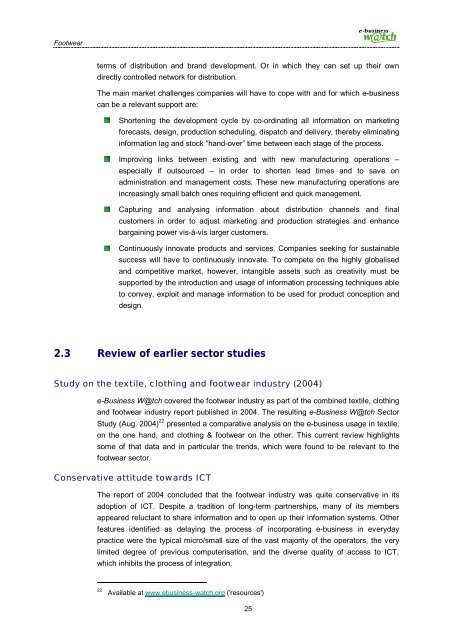Footwear Industry Footwear Industry - empirica
Footwear Industry Footwear Industry - empirica
Footwear Industry Footwear Industry - empirica
You also want an ePaper? Increase the reach of your titles
YUMPU automatically turns print PDFs into web optimized ePapers that Google loves.
<strong>Footwear</strong><br />
terms of distribution and brand development. Or in which they can set up their own<br />
directly controlled network for distribution.<br />
The main market challenges companies will have to cope with and for which e-business<br />
can be a relevant support are:<br />
Shortening the development cycle by co-ordinating all information on marketing<br />
forecasts, design, production scheduling, dispatch and delivery, thereby eliminating<br />
information lag and stock “hand-over” time between each stage of the process.<br />
Improving links between existing and with new manufacturing operations –<br />
especially if outsourced – in order to shorten lead times and to save on<br />
administration and management costs. These new manufacturing operations are<br />
increasingly small batch ones requiring efficient and quick management.<br />
Capturing and analysing information about distribution channels and final<br />
customers in order to adjust marketing and production strategies and enhance<br />
bargaining power vis-à-vis larger customers.<br />
Continuously innovate products and services. Companies seeking for sustainable<br />
success will have to continuously innovate. To compete on the highly globalised<br />
and competitive market, however, intangible assets such as creativity must be<br />
supported by the introduction and usage of information processing techniques able<br />
to convey, exploit and manage information to be used for product conception and<br />
design.<br />
2.3 Review of earlier sector studies<br />
Study on the textile, clothing and footwear industry (2004)<br />
e-Business W@tch covered the footwear industry as part of the combined textile, clothing<br />
and footwear industry report published in 2004. The resulting e-Business W@tch Sector<br />
Study (Aug. 2004) 22 presented a comparative analysis on the e-business usage in textile,<br />
on the one hand, and clothing & footwear on the other. This current review highlights<br />
some of that data and in particular the trends, which were found to be relevant to the<br />
footwear sector.<br />
Conservative attitude towards ICT<br />
The report of 2004 concluded that the footwear industry was quite conservative in its<br />
adoption of ICT. Despite a tradition of long-term partnerships, many of its members<br />
appeared reluctant to share information and to open up their information systems. Other<br />
features identified as delaying the process of incorporating e-business in everyday<br />
practice were the typical micro/small size of the vast majority of the operators, the very<br />
limited degree of previous computerisation, and the diverse quality of access to ICT,<br />
which inhibits the process of integration.<br />
22<br />
Available at www.ebusiness-watch.org ('resources')<br />
25

















